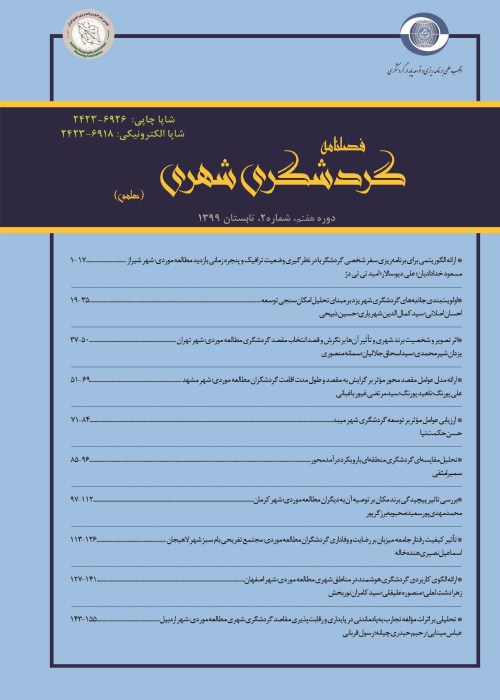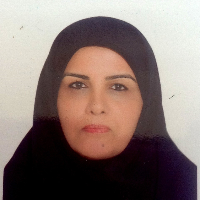Evaluation of Desirable Pedestrian Axes in order to Promote Urban TourismCase Study: Central and Historical Texture of Saqqez City
Since the late 1960s, as a result of the exacerbation of urban problems, there has been a widespread reaction against the dominance of ride. In this regard, the pedestrian movement, which aimed to restore and develop pedestrian spaces in cities, became one of the axes of urban planning and design. On the other hand, in recent decades, the central and old textures of cities have been left to their own devices and due to negligence, they have faced many problems. Highlighting historical places, producing and reproducing collective memories and centers of attachment, is the first step to mental attraction to historical environments, which raises a broad category and a phenomenon called urban tourism. One of the cases that helps to rebuild these textures is to pay attention to pedestrians and humanizing the environment, so today's urban community needs studies that analyze and scrutinize pedestrian crossings in the city and encourage the citizen to find a new balance between different ways of moving. The revival of the historical textures that make up the core of cities, in addition to improving the quality of the environment and re-establishing social life, also promotes tourism. Saqqez city, which is one of the oldest cities in Iran and the world, despite its significant population in Kurdistan province and its high potential, such as a complex of amusement parks along the river, the city's historic Grand Bazaar and a large number of travelers to buy from the border town of Baneh, it lacks the ability to attract tourists in its proper form; therefore, planning for the mentioned spaces to attract tourists and spend leisure time is very important in the development of this city. The present study tried to identify the desired axes of walking in the central part of the historical city of Saqqez to promote urban tourism and to suggest the selected axis to create pedestrian path.
The present study is an applied one in terms of purpose and also is based on quantitative methods. The statistical population of this study includes residents of Saqqez city and tourists who visit the city's attractions. The volume of statistical sample according to the population of Saqez city in 2016, which is 226451 people, has been considered. By using of the Cochran's formula, the number of selected samples to distribute the questionnaire among urban residents and tourists is 384. In order to implement the Delphi method, the opinions of 12 Saqqez experts and city managers have been used. In order to select the selected axis using the Inverted Hierarchical Weight Process (IHWP) and define and refine the criteria, the level of interference of the central texture of Saqqez city was proposed to suggest the necessary fields of walkability. Finally, through measurement quantification, calculations related to feasibility and prioritization, after feasibility of axes in the historical central texture of Saqqez city, using the Quantitative Analyze Matrix (QAM) model, the axis that received the highest score in terms of walkability was selected as the pedestrian target axis for planning.
The study area at the historic center of Saqqez city has valuable grounds and buildings in which physical intervention is subject to its own limitations. Therefore, in order to increase the coefficient of realization of the research, at first, the capability of intervening the areas in the texture was analyzed by IHWP method and the most intervention textures were designated to locate and select the appropriate axis to create the pedestrian path. After collecting the scores of each of the intervention criteria and the formation of the database, they are classified into four classes and the central texture of Saqqez city in four priorities of completely desirable, relatively desirable, relatively undesirable and completely undesirable lands for intervention-based services, which the Imam Khomeini, Jomhouri, Saheli, Beheshti and Vali Khan axes were identified to provide support services for the pedestrian axes. Then, in order to locate and select the appropriate axis of the pedestrian path using the Quantitative Analyze Matrix (QAM) model, after introducing the prone streets of the area and after going through the Delphi method and weighting steps using Expert Choice software through comparative comparison according to the extracted criteria and in the form of a Likert scale, the axes were examined and finally, among the axes in the central core of Saqqez city, Imam axis was selected with a score of (2.84) for pedestrian path planning.
Today, feasibility studies of desirable pedestrian axes are one of the urban needs in this area. In the present study, after performing quantitative calculations and qualitative analyzes, Imam axis gained the highest score with a relatively desirable quality status for creating pedestrian path in the central core of Saqqez city. It is natural that over time, the coefficient of importance and current status of each axis has changed, and given the tourism potential of other axes, it is not unreasonable to expect that in the coming years other axes will have a higher score and create the desired pedestrian path. Looking at the findings of the present study, it can be inferred that in the middle cities of Iran, especially those with a population of less than 250,000 and also according to economic, political, managerial, cultural, physical, spatial situations, etc., the potential of such cities to create the pedestrian path was low unless the city's historical dimension and the presence of prominent historical elements were influential enough to send a significant population to the city; because the demographic factor is a very important element in the creation and prosperity of the pedestrian path. So, looking at the current situation of the streets of the central part of Saqqez city and the results of the analysis, the relatively favorable option does not create a significant for urban management to create pedestrian path, and only with the passage of time and reaching the age of 20-30 can tourism flourish and hoped to revive the historical texture by creating sidewalks.
walkability , Urban Tourism , Central , Historical Texture , IHWP , QAM , Saqqez City
- حق عضویت دریافتی صرف حمایت از نشریات عضو و نگهداری، تکمیل و توسعه مگیران میشود.
- پرداخت حق اشتراک و دانلود مقالات اجازه بازنشر آن در سایر رسانههای چاپی و دیجیتال را به کاربر نمیدهد.




